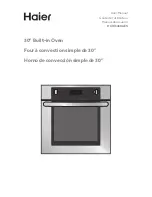
English - 26
English - 26
cooking techniques
RECOMMENDED
Stirring
Stir foods such as casseroles and vegetables while cooking to distribute heat evenly.
Food at the outside of the dish absorbs more energy and heats more quickly, so stir from
the outside to the center. The oven will turn off when you open the door to stir your food.
Arrangement
Arrange unevenly shaped foods, such as chicken pieces or chops, with the thicker,
meatier parts toward the outside of the turntable where they receive more microwave
energy. To prevent overcooking, place thin or delicate parts toward the center of the
turntable.
Shielding
Shield food with narrow strips of aluminum foil to prevent overcooking. Areas that need
shielding include poultry wing-tips, the ends of poultry legs, and corners of square baking
dishes. Use only small amounts of aluminum foil. Larger amounts can damage your oven.
Turning
Turn foods over midway through cooking to expose all parts to microwave energy. This is
especially important with large items such as roasts.
Standing
Foods cooked in the microwave build up internal heat and continue to cook for a few
minutes after the oven stops. Let foods stand to complete cooking, especially foods such
as roasts and whole vegetables. Roasts need this time to complete cooking in the center
without overcooking the outer areas. All liquids, such as soup or hot chocolate, should be
shaken or stirred when cooking is complete. Let liquids stand a moment before serving.
When heating baby food, stir well and test the temperature before serving.
Adding moisture
Microwave energy is attracted to water molecules. Food that is uneven in moisture
content should be covered or allowed to stand so that the heat disperses evenly. Add a
small amount of water to dry food to help it cook.
General tips
• Dense foods, such as potatoes, take longer to heat than lighter foods. Foods with a
delicate texture should be heated at a low power level to avoid becoming tough.
• Altitude and the type of cookware you are using can affect cooking time. When using
a new recipe, use the minimum cooking time and check the food occasionally to
prevent overcooking.
• Foods with a non-porous skin such as potatoes or hot dogs, should be pierced to
prevent bursting.
• Frying with heating oil or fat is not recommended. Fat and oil can suddenly boil over
and cause severe burns.
• Some ingredients heat faster than others. For example, the jelly inside a jelly
doughnut will be hotter than the dough. Keep this in mind to avoid burns.
• Home canning in the microwave oven is not recommended because all harmful
bacteria may not be destroyed by the microwave heating process.
• Although microwaves do not heat the cookware, the heat from the food is often
transferred to the cookware. Always use pot holders when removing food from the
microwave and instruct children to do the same.
• Making candy in the microwave is not recommended as candy can heat to very high
temperatures. Keep this in mind to avoid injury.
Auto sensor cook
The Auto Sensor allows you to cook your food automatically by detecting the amount of
moistures generated from the food while cooking.
• When cooking food, many kinds of moistures are generated. The Auto Sensor
determines the proper time and power level by detecting these moistures from the
food, eliminating the need to set the cooking time and power level.
• When you cover a container with its lid or plastic wrap during Sensor Cooking,
the Auto Sensor will detect the moistures generated after the container has been
saturated with steam.
• Shortly before cooking ends, the remaining cooking time will begin its count down.
This will be a good time for you to rotate or stir the food for even cooking if it is
necessary.
• Before auto sensor cooking food may be seasoned with herbs, spices or browning
sauces. A word of caution though, salt or sugar may cause burn spots on food so
these ingredients should be added after cooking.
ME1113TST1_XSA_DE68-04302A-01_EN.indd 26
2014-08-18 4:53:42







































